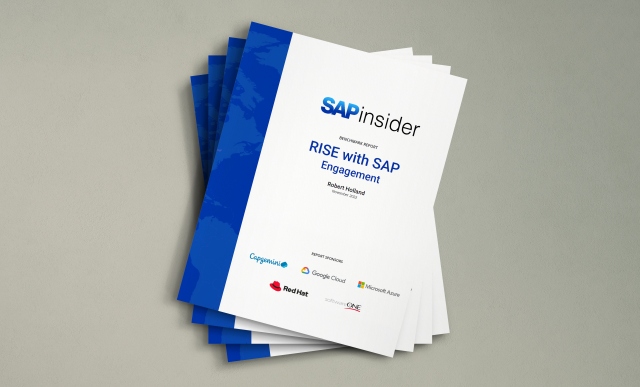SAP Completes Strong Q2, Eyes APJ Expansion with Alibaba Partnership
Meet the Authors
Key Takeaways
⇨ SAP reported strong Q2 2025 earnings with a 22% increase in cloud backlog and significant revenue growth, particularly in Cloud ERP Suite (up 30%). AI played a crucial role in performance, driving over half of the cloud order volume while SAP's generative AI assistant Joule was integrated across solutions.
⇨ The strategic partnership with Alibaba is expected to boost cloud revenue growth in the Asia Pacific and Japan region, targeting multinationals already operating in China. This partnership aims to enhance productivity and logistics for customers in that market.
⇨ SAP has completed its global restructuring, affecting 10,000 employees, which is expected to positively impact financial reporting moving forward. The company is focusing on fine-tuning its workforce with continuous adjustments rather than large-scale restructurings.
Economic uncertainty may be impacting the second quarter announcements for some companies over the next week, but that wasn’t the case during SAP’s Q2 2025 earnings call. The German software maker followed a strong first quarter with an equally strong second quarter that included current cloud backlog increasing 22% to €18 billion, total revenue up 9% to €9 billion, cloud revenue up 24% to €5.1 billion, and Cloud ERP Suite revenue up 30% to €4.4 billion. Not only was this another quarter of very strong growth in the Cloud ERP Suite, CEO Christian Klein stated that this was the 14th consecutive quarter in which Cloud ERP Suite drove cloud revenue.
Beyond the top-line performance, SAP also had a very strong bottom line with cloud gross profit increasing 27% to €3.86 billion, gross profit up 10% to €6.64 billion, and operating profit up 32% to €2.57 billion compared to the same quarter last year. In his prepared remarks, Klein noted that AI had a strong impact on performance, with over half the cloud order entry volume in the quarter coming from deals with AI use cases. This was partly driven by SAP making the generative AI assistant Joule available across nearly all solutions. This will be extended further in the second half of the year as SAP further integrates WalkMe and its partnership with Perplexity starts to have a greater impact.
Strong Regional Performance and Alibaba Partnership
Strong growth in each region drove this robust overall cloud performance. This was led by cloud revenue increasing by 33% in APJ to €753 million and by 29% in EMEA to €2.16 billion. While cloud revenue growth was not as strong in the Americas, it still increased by 16% to €2.22 billion. CFO Dominik Asam called out India, South Korea, France, Italy, Spain, Brazil, and Chile as having outstanding cloud revenue growth while China, Japan, Germany, and Canada were described as particularly strong.
Explore related questions
A significant announcement that is likely to increase cloud revenue growth in APJ is that SAP has entered a strategic partnership with Alibaba. The initial focus will be an end-to-end roll out of SAP Business Suite on Alibaba plus the China-based hyperscaler will also become a partner for the RISE with SAP and GROW with SAP journeys. While Alibaba is not extensively used outside of the Chinese market, SAP hopes that this will help it address the huge market potential in the region both among the existing install base and with new customers.
During the question-and-answer portion of the call, Klein stated that the partnership with Alibaba, and the Chinese market, needed to be examined from multiple angles. One of the biggest reasons for the announcement is that nine in ten of the multinationals that SAP is working with outside China are also doing business in China. These organisations are looking for solutions that will help drive their productivity in the region, improve logistics, and improve supply chain resiliency. With Alibaba, there is now a partner that can deliver SAP’s cloud in China. While Klein admitted that the Chinese market is currently smaller than other countries, SAP is seeing considerable growth in the region.
Global Restructuring is Now Complete
Another positive impact on SAP’s financial reporting this quarter was that the company has now completed the global restructuring that started in the first half of 2024. While SAP’s initial estimates for the restructuring were estimated to affect up to 7,000 employees and incur costs of approximately €2 billion, the final impact was much greater. As many as 10,000 employees ended up leaving SAP with many more than expected taking advantage of the “voluntary early retirement program”. Almost all the additional 3,000 employee departures were those taking early retirement. This lead to an increase in restructuring costs of nearly €1 billion and a delay of up to a year as many of those transitioning were based in Europe. With the changes complete those restructuring costs are no longer impacting SAP’s bottom line.
While Asam indicated that SAP is not currently planning any further restructuring, he did indicate that the company will continue to “fine tune and adjust” its workforce. This is most likely to present as a continuous adjustment rather than a large-scale restructuring program, and the optimisations would be of “much smaller magnitude” and might represent from 1-2% of the workforce in annual adjustments. Asam did not rule out the need for future severance payments in certain geographies but did not expect an adjustment to the non-IFRS operating profit as a result. While these numbers may not seem huge it must be noted that SAP currently has nearly 107,000 employees so a 1% or 2% change is still significant.
Product Impact on Performance
Klein made relatively few product references during the earnings call. The biggest of these was the emphasis on SAP Business Suite and the Cloud ERP Suite revenue discussion in conjunction with the role that AI is playing in helping drive revenue. However, Klein also noted that more than 300 customers selected Digital Supply Chain solutions during the quarter, and nearly 100 selected SAP’s customer engagement platform. More than 300 customers also signed up for human capital management solutions, specifically SAP SuccessFactors.
SAP Business Data Cloud (BDC) was also a key component in many second quarter deals, and Klein mentioned that SAP will be deepening its partnership with Palantir around SAP BDC. From an AI perspective, Klein celebrated the fact that SAP released 14 AI agents during the first quarter and expects that number to reach 40 by the end of the year. These agents will work across all business functions and address all buying centers in finance. Klein provided a sample of agents that streamline financial planning, ensure accruals are automatically calculated and proactively identify cash shortages. These agents keep production moving by recommending and onboarding suppliers and proactively responding to shop floor disruptions. Additionally, these agents will enhance the capabilities already offered through Joule.
What This Means for Mastering SAP Insiders
SAP expects to expand its business significantly in Asia Pacific and Japan. While APJ may represent less than 15% of SAP’s total business this quarter, the announcement of the Alibaba partnership and SAP’s focus on customers doing business and located in China means that there is an expectation of growth. If the same rate of cloud revenue growth persists in APJ, the region may exceed €1 billion in quarterly cloud revenue within the next two years, something that will make SAP’s investments worthwhile. Although this is an estimate, SAP would not be making the significant investments that they are without an expectation of accelerating growth.
Artificial intelligence and SAP BDC are leading the way in driving revenue growth. Although SAP BDC was only announced earlier this year and it will take much of 2025 for all the announced features to be fully available, the offering is already having a significant impact on revenue. This is doubly true for AI. Just as SAP is looking to accelerate its own growth by 2027 through an AI-powered transformation of its workforce, the company is focusing its efforts on achieving the same goals for customers. This involves helping business run with data and AI, accelerating the journey to SAP Business Suite, and scaling using business AI. All these capabilities are helping SAP drive cloud revenue, and Mastering SAP Insiders need to understand where SAP’s focus will be in the coming years even if they are still trying to determine how they will complete ERP transformation.
Cloud-based solutions are what SAP wants every customer to be running. Some may be confused by the change from RISE with SAP and GROW with SAP to be journeys rather than packages; the role SAP Cloud ERP is now playing in the ecosystem, and how the “new” SAP Business Suite is different from SAP Suite on HANA, but the bottom line is that everything is moving to the cloud. AI capabilities are only available in cloud-based solutions. SAP Business Suite encompasses not just SAP S/4HANA Cloud but an entire suite of cloud-based solutions including financial management, supply chain management, human capital management, and customer experience solutions plus SAP Build, SAP Signavio, SAP LeanIX, SAP BTP, and SAP BDC. SAP’s immediate and long-term goals involve moving customers to these offerings and SAP professionals need to understand what that means.





